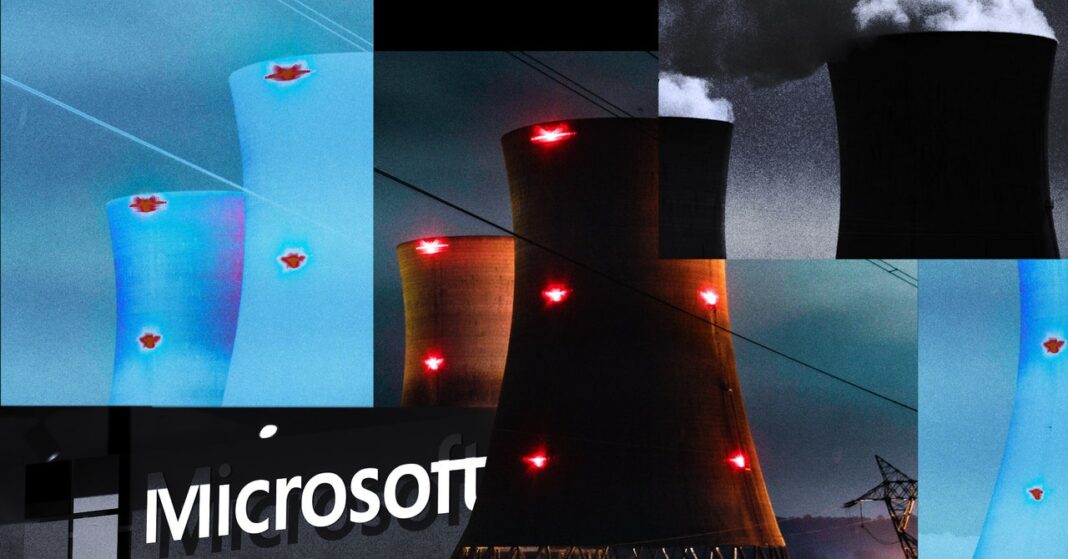In Short:
The Three Mile Island nuclear power station in Pennsylvania will restart its reactor one in 2028 to supply Microsoft with low-carbon electricity, following a deal. As tech companies like Microsoft and Amazon seek sustainable energy amid rising AI demand, the nuclear industry sees new opportunities. AI could double electricity needs by 2026, prompting interest in nuclear power for consistent energy supply.
For five years, reactor one at Three Mile Island nuclear power station in Pennsylvania has remained inactive. However, a recent agreement with Microsoft will see the reactor become operational again in 2028, exclusively supplying the tech company with substantial amounts of low-carbon electricity.
Collaboration Between Tech Giants and Nuclear Energy
This initiative is part of a broader trend where major technology firms are increasingly exploring partnerships with the nuclear power sector. In March, Amazon Web Services entered into a deal to acquire a data center powered by the Susquehanna nuclear power station in Pennsylvania. During an event at Carnegie Mellon University on September 18, Alphabet CEO Sundar Pichai highlighted small modular nuclear reactors as a promising energy source for data centers. Furthermore, OpenAI CEO Sam Altman serves on the boards of several nuclear startups, including Oklo and Helion Energy.
Rising Energy Demands from AI
The surge in artificial intelligence (AI) has intensified competition among technology firms for sustainable energy solutions to power their expanding data centers. The International Energy Agency projects that electricity demand from AI, data centers, and cryptocurrency could more than double by 2026. Even conservative estimates suggest that this demand may match the total electricity consumption of Sweden or approach that of Germany under high-usage scenarios.
Nuclear Power’s Renewed Significance
This increase in energy demand presents a significant opportunity for the nuclear power industry. Traditionally, electricity demand in the United States has remained stable, but the dramatic growth associated with the AI boom is shifting this trend. A December 2023 report from a power industry consultancy indicates that the era of stagnant demand is over, attributing this shift to rising consumption from data centers and industrial operations. It forecasts a growth of 38 gigawatts in peak electricity demand in the US by 2028, equivalent to approximately 46 times the output of reactor one at Three Mile Island.
The Intersection of Energy and National Security
Reflecting on these developments, John Kotek, senior vice president for policy development and public affairs at the Nuclear Energy Institute, notes the heightened attention to AI within the energy sector. He emphasizes that national security concerns are contributing to this focus, as there is apprehension about the US potentially lagging in the AI race due to inadequate power supply.
Advantages of Nuclear Power for Microsoft
Nuclear energy is particularly appealing to technology companies because it offers a consistent supply of low-carbon power, unlike solar and wind energy, which can be intermittent unless paired with energy storage solutions. The reactivation of reactor one will provide Microsoft with 835 megawatts of low-carbon energy over the 20-year duration of the agreement. With Microsoft committed to achieving carbon negativity by 2030, the rapidly escalating electricity demands from AI pose a significant challenge to the company’s climate objectives. Notably, Microsoft’s emissions surged by 29 percent in 2023 compared to 2020, primarily driven by the expansion of new data centers.
The Future of Three Mile Island
The Three Mile Island nuclear power station houses two reactors, one of which was the site of a significant partial meltdown in 1979, rendering it inactive since then. Reactor one, however, operated safely until being decommissioned in 2019 due to financial challenges, mainly arising from competition with gas and wind energy. Kotek indicated that while there are relatively few idle reactors available for quick reactivation, many power plant owners are expressing interest in extending the operating licenses of their existing facilities to capitalize on the forthcoming surge in energy demand driven by AI.





